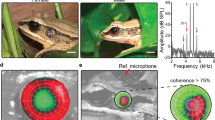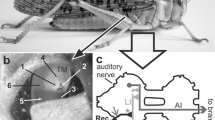Abstract
Tympanal organs are widespread in Nymphalidae butterflies, with a great deal of variability in the morphology of these ears. How this variation reflects differences in hearing physiology is not currently understood. This study provides the first examination of hearing organs in the crepuscular owl butterfly, Caligo eurilochus. We examined the tuning and sensitivity of the C. eurilochus hearing organ, called Vogel’s organ, using laser Doppler vibrometry and extracellular neurophysiology. We show that the C. eurilochus ear responds to sound and is most sensitive to frequencies between 1 and 4 kHz, as confirmed by both the vibration of the tympanal membrane and the physiological response of the associated nerve branches. In comparison to the hearing of its diurnally active relative, Morpho peleides, C. eurilochus has a narrower frequency range with higher auditory thresholds. Hypotheses explaining the function of hearing in this crepuscular butterfly are discussed.




Similar content being viewed by others
References
Ackery PR, de Jong R, Vane-Wright RI (1999) The butterflies: Hedyloidea, Hesperoidea and Papilionoidea. In: Kristensen N (ed) Handbook of zoology. Arthropoda: Insecta. Lepidoptera, moths and butterflies, Vol. 1. Evolution, systematics, and biogeography. Walter de Gruyter, Berlin, pp 263–300
DeVries PJ (1987) The butterflies of Costa Rica and their natural history. Vol I: Papilionoidea, Pieridae, Nymphalidae. University of Chicago Press, Chicago
Fournier JP, Dawson JW, Mikhail A, Yack JE (2013) If a bird flies in the forest, does an insect hear it? Biol Lett 9:20130319. doi:10.1098/rsbl.2013.0319
Frederiksen R, Warrant EJ (2008) Visual sensitivity in the crepuscular owl butterfly Caligo memnon and the diurnal blue morpho Morpho peleides: a clue to explain the evolution of nocturnal apposition eyes? J Exp Biol 211:844–851. doi:10.1242/jeb.012179
Fullard JH (1994) Auditory changes in noctuid moths endemic to a bat-free habitat. J Evol Biol 445:435–445
Fullard JH, Dawson JW, Otero LD, Surlykke A (1997) Bat-deafness in day-flying moths (Lepidoptera, Notodontidae, Dioptinae). J Comp Physiol A 181:477–483
Fullard JH, Ratcliffe JM, ter Hofstede HM (2007) Neural evolution in the bat-free habitat of Tahiti: partial regression in an anti-predator auditory system. Biol Lett 3:26–28. doi:10.1098/rsbl.2006.0550
Fullard JH, ter Hofstede HM, Ratcliffe JM et al (2010) Release from bats: genetic distance and sensoribehavioural regression in the Pacific field cricket, Teleogryllus oceanicus. Naturwissenschaften 97:53–61. doi:10.1007/s00114-009-0610-1
Hallberg E, Poppy G (2003) Exocrine glands: chemical communication and chemical defense. In: Kristensen N (ed) Vol 2: Morphology, physiology, and development. Handbook of zoology, Arthropoda: Insecta. Lepidoptera, moths and butterflies. Walter de Gruyter, Berlin, pp 361–375
Lane KA, Lucas KM, Yack JE (2008) Hearing in a diurnal, mute butterfly, Morpho peleides (Papilionoidea, Nymphalidae). J Comp Neurol 508:677–686. doi:10.1002/cne.21675
Lehmann GUC, Berger S, Strauss J et al (2010) The auditory system of non-calling grasshoppers (Melanoplinae: podismini) and the evolutionary regression of their tympanal ears. J Comp Physiol A 196:807–816. doi:10.1007/s00359-010-0560-2
Lucas KM, Windmill JFC, Robert D, Yack JE (2009) Auditory mechanics and sensitivity in the tropical butterfly Morpho peleides (Papilionoidea, Nymphalidae). J Exp Biol 212:3533–3541. doi:10.1242/jeb.032425
Mahony S (2006) Hearing in the speckled wood butterfly, Parage aegeria (Nymphalidae: Satyrinae). M. Sc. Dissertation, Carleton University
Minet J, Surlykke A (2003) Sound producing and auditory organs. In: Kristensen NP (ed) Vol 2: Morphology, physiology, and development. Handbook of Zoology, Arthropoda: Insecta. Lepidoptera, moths and butterflies. Walter de Gruyter, Berlin, pp 289–323
Otero LD (1990) Estudio de algunos caracteres para su uso en la classificacion de Eurytelinae (Lepidoptera). Bol Entomol Venez 5:123–128
Penz CM, DeVries PJ (2002) Phylogenetic analysis of Morpho butterflies (Nymphalidae, Morphinae): implications for classification and natural history. Am Museum Novit 3374:1–33
Pollack GS, Martins R (2007) Flight and hearing: ultrasound sensitivity differs between flight-capable and flight-incapable morphs of a wing-dimorphic cricket species. J Exp Biol 210:3160–3164. doi:10.1242/jeb.008136
Ribaric D, Gogala M (1996) Acoustic behaviour of some butterfly species of the genus Erebia (Lepidoptera: satyridae). Acta Entomol Slov 4:5–12
Rydell J, Kaerma S, Hedelin H, Skals N (2003) Evasive response to ultrasound by the crepuscular butterfly Manataria maculata. Naturwissenschaften 90:80–83. doi:10.1007/s00114-002-0391-2
Scoble MJ (1996) In search of butterfly origins: morphology and molecules. Trends Ecol Evol 11:274–275
Spangler HG (1988) Moth hearing, defense, and communication. Annu Rev Entomol 33:59–81
Srygley RB (1994) Shivering and its cost during reproductive behaviour in Neotropical owl butterflies, Caligo and Opsiphanes (Nymphalidae: brassolinae). Anim Behav 47:23–32
Surlykke A, Skals N, Rydell J, Svensson M (1998) Sonic hearing in a diurnal geometrid moth, Archiearis parthenias, temporally isolated from bats. Naturwissenschaften 85:36–37. doi:10.1007/s001140050449
ter Hofstede HM, Ratcliffe JM, Fullard JH (2008) Nocturnal activity positively correlated with auditory sensitivity in noctuoid moths. Biol Lett 4:262–265. doi:10.1098/rsbl.2007.0617
Vogel R (1912) Über die chordotonalorgane in der wurzel der schmetterlingsflügel. Zeitschrift fur Wissenschaftliche Zool 100:210–244
Warrant E, Kelber A, Kristensen NP (2003) Visual organs. In: Kristensen N (ed) Vol 2: Morphology, physiology, and development. Handbook of Zoology, Arthropoda: Insecta. Lepidoptera, moths and butterflies. Walter de Gruyter, Berlin, pp 325–359
Windmill JFC, Göpfert MC, Robert D (2005) Tympanal travelling waves in migratory locusts. J Exp Biol 208:157–168. doi:10.1242/jeb.01332
Yack JE (2004) The structure and function of auditory chordotonal organs in insects. Microsc Res Tech 63:315–337. doi:10.1002/jemt.20051
Yack JE, Fullard JH (2000) Ultrasonic hearing in nocturnal butterflies. Nature 403:265–266. doi:10.1038/35002247
Yack JE, Otero LD, Dawson JW et al (2000) Sound production and hearing in the blue cracker butterfly Hamadryas feronia (Lepidoptera, Nymphalidae) from Venezuela. J Exp Biol 203:3689–3702
Yack JE, Kalko EKV, Surlykke A (2007) Neuroethology of ultrasonic hearing in nocturnal butterflies (Hedyloidea). J Comp Physiol A 193:577–590. doi:10.1007/s00359-007-0213-2
Yager DD (1999) Structure, development, and evolution of insect auditory systems. Microsc Res Tech 47:380–400. doi:10.1002/(SICI)1097-0029(19991215)47:6<380:AID-JEMT3>3.0.CO;2-P
Acknowledgments
We thank Ed Bruggink (Carleton University) and Vicky Pook (University of Bristol) for help rearing the butterflies. This work was funded by a Journal of Experimental Biology Travelling Fellowship to K.M.L., the Canadian Foundation for Innovation, Ontario Innovation trust, and NSERC to J.E.Y., the BBSRC to J.F.C.W. and D.R., and the Royal Society (D.R.).
Author information
Authors and Affiliations
Corresponding author
Electronic supplementary material
Below is the link to the electronic supplementary material.
Online Resource 1. Animation of tympanal deflections in Caligo eurilochus at 2.5 kHz. (MPG 852 kb)
Rights and permissions
About this article
Cite this article
Lucas, K.M., Mongrain, J.K., Windmill, J.F.C. et al. Hearing in the crepuscular owl butterfly (Caligo eurilochus, Nymphalidae). J Comp Physiol A 200, 891–898 (2014). https://doi.org/10.1007/s00359-014-0933-z
Received:
Revised:
Accepted:
Published:
Issue Date:
DOI: https://doi.org/10.1007/s00359-014-0933-z




